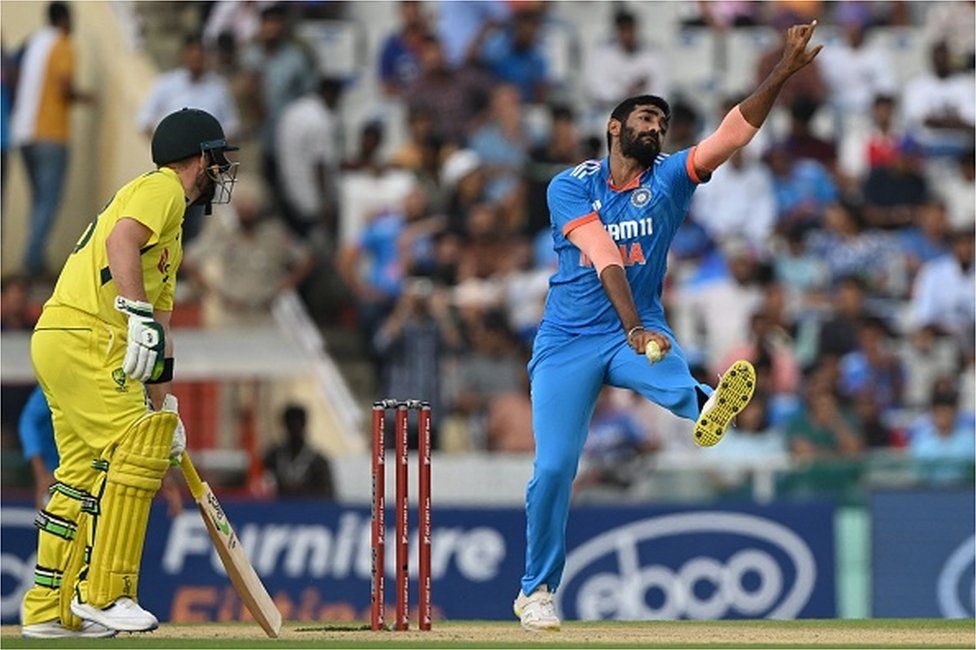When India first won the cricket World Cup in 1983, its bowlers were mainly all-rounders.
Many were called ‘bits-and-pieces’ cricketers (who could bowl a bit and bat a bit), but with a couple of exceptions – skipper Kapil Dev being the biggest one – most wouldn’t find a place in the team for their bowling alone.
There was Madan Lal, Roger Binny, Sandeep Patil, Mohinder Amarnath and only two specialist medium pacers, Balwinder Sandhu and Sunil Valson. The lone spinner in the squad was Ravi Shastri, who didn’t play the final.
India called on six bowlers in that game. Patil wasn’t needed, and nor was opener Krishnamachari Srikkanth who in later years was good enough to claim five wickets in an innings against New Zealand with his off spin. Amarnath’s gentle (almost kind) pace contributed to his Man of the Match awards in both the semi-finals and final.
- Why Jasprit Bumrah is so important for Indian cricket
But 40 years ago, the essence of one-day cricket was slightly different. The focus was not so much on taking wickets as on keeping the run-scoring in check. Over the years, the emphasis shifted to dismissing batters (on the sensible theory that a batter who is out cannot score runs), and now the need is for wicket-takers rather than defensive bowlers.
In India’s win at home in the 2011 World Cup, top batters Sachin Tendulkar, Yuvraj Singh, Virender Sehwag and Suresh Raina could all bowl. Only the first two were needed in the final where seven bowled, including Virat Kohli.

Seven of the 12 most successful bowlers in that tournament were medium pacers, with India’s Zaheer Khan claiming the most wickets (21), the same as Pakistan’s leg spinner Shahid Afridi.
In that squad, apart from Khan, the medium pacers were S Sreesanth, Munaf Patel, Ashish Nehra and Praveen Kumar while Harbhajan Singh, Piyush Chawla and Ravichandran Ashwin were the spinners. The focus was clearly on pace then, as it is likely to be this year too.
The bits-and-pieces players of 1983 have given way to the specialists of 2023 in an Indian team that doesn’t have anyone in the top half who can turn his arm over. This is a bit unfair on the bottom half, for bowlers are also expected to bat a little.
This seems to go against the logic of the shorter game where, theoretically, everybody is expected to do a bit of everything. But you can only use the players you have.
Is India’s strength spin or pace?
A line-up of Jasprit Bumrah, Mohammed Siraj, Mohammed Shami, Shardul Thakur and Hardik Pandya suggests that it is pace, especially with Bumrah back in the team after recovering from a back injury and bowling close to his best.

Bumrah will have an important role to play, while Siraj’s heroics at the Asia Cup finals might get him the nod ahead of the others. When the third medium pacer’s slot is a choice between Shami and Thakur, you know you have a terrific unit.
While there is little idea of the kind of wickets being prepared (in 2011, the tournament was played in March-April), it is safe to assume that at least initially fast bowlers will play the major role.
It will be a while before the wickets begin to aid spin as more matches are played. Then there is the dew to consider, which often works against spin for the team that bowls second. Play starts at 2pm local time, so there might be a small window before the lights come on for medium pacers to swing the ball. So it’s down to balance once again. You need bowling for all occasions.
And India have just that.
Kuldeep Yadav has emerged as the leading ODI spinner on current form. If Ashwin makes it to the final squad, then India will have the best spin combination, with Ravindra Jadeja giving India the luxury of playing three spinners. A call will have to be taken on Axar Patel’s fitness, but if Ashwin comes through it will not cause as much worry as it might otherwise have.

England have an excellent pace attack (Mark Wood, Chris Woakes, Reece Topley, David Willey, Sam Curran), Australia have Mitchell Starc, Josh Hazlewood, Pat Cummins, Marcus Stoinis, Cameron Green. And despite the injury to Naseem Shah forcing a change, Pakistan still have an impressive line-up in Shaheen Afridi, Haris Rauf, Hasan Ali and Mohammad Wasim.
It might be tempting to see the World Cup as a battle between pace attacks. In that case, India hold their own comfortably – the most dramatic change in the team since their first World Cup win.
Sports writer Suresh Menon has written books on Sachin Tendulkar and Bishan Bedi.
BBC News India is now on YouTube. Click here to subscribe and watch our documentaries, explainers and features.

Read more India stories from the BBC:
- Air India 1985 bombing back in news after Canada row
- India row after LGBTQ couple marry in Sikh temple
- Humans of New York slams Indian firm’s copyright suit
- Hopes dim as India awaits signal from Moon lander
- Trudeau facing cold reality after lonely week on world stage

